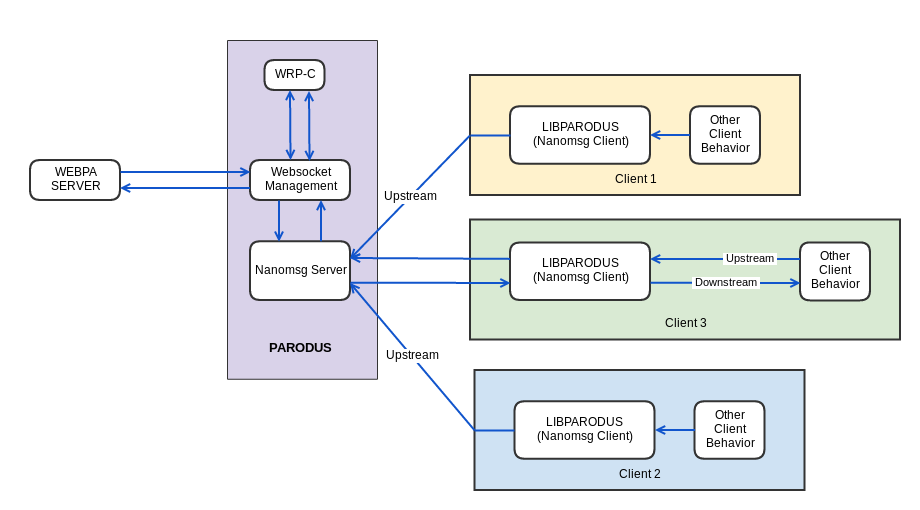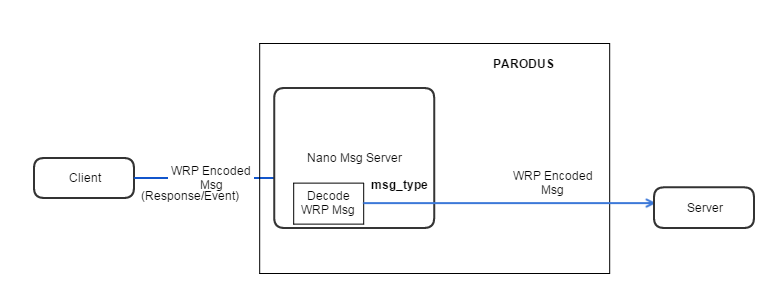-
Notifications
You must be signed in to change notification settings - Fork 53
Parodus In Detail
WebPA is the communication channel from Cloud to RDK based home gateway devices. It helps to manage devices from Cloud. WEBPA protocol provides functionality of read/write access to device management parameters in an efficient manner as compared to TR-69 or SNMP.
The main idea behind Parodus is to separate the core Webpa routing from the platform specific service. Parodus is a websocket client which connects to server in the cloud & delivers messages to and from services running on the gateway device. Parodus provides communication mechanism between clients (e.g. Client1, Client2, Client3) and server.

PARODUS STRUCTURE
-
Websocket client: Nopoll library used as Websocket Client. Nopoll is an OpenSource WebSocket implementation ( **RFC 6455 **). It allows building pure WebSocket solutions or to provide WebSocket support to existing TCP oriented applications. Nopoll handles all the messages coming from or to the server asynchronously.
-
Nanomsg Server: Parodus acts asNanomsg server to distribute messages upstream and downstream (ref. nanomsg).
Nanomsg is used to communicate with Parodus on the device. Nanomsg acts like internal bus. Client Server model is used where Parodus is server. This replaces previously defined RPC mechanisms. Message queues are implemented for both incoming WRP messages and outgoing WRP messages from nanomsg. This is same as nopoll incoming and outgoing queue architecture. Nanomsg is used in the following capacities:
· Nanomsg Server: Parodus is a nanomsg server that listens to incoming client requests & provides a mechanism for services on the device to register with Parodus.
· libparodus/Nanomsg Client: Libparodus is provided as a simple c library for any client that wants to communicate with Parodus. Service registration as well as "fire and forget" use cases are supported.
This message is used by on device services that wish to register to parodus. During registration service name and port for sending data will be shared as part of this new WRP message registration_message. Registration msg will be sent to nanomsg server, that msg will contain specific URL of that client and service port number.
These registration port and service details are stored in a list in parodus which will be used to push or send messages downstream. Whenever any client gets registered with parodus that client will be added to that list. Clients will get deleted from that list when parodus observes that client is killed or dead.

Client Registration
To maintain connection with clients parodus sends keep alive messages to clients. It acts like heart beats.
Upstream means sending messages from Device to Cloud. WRP Msg_type 4 (msg_format) is used as upstream message. Upstream does not require any registration. Upstream messages will be received as PULL on fixed pre-defined port in Parodus which will be known to all clients without requiring any registration.

Upstream Flow
Downstream means sending messages from Cloud to Device. WRP Msg_type 3 (msg_format) is used as downstream message. Parodus processes request coming through webpa server and sends to appropriate client by referring registered client list. Downstream requires registration, during registration service name and port for sending data will be shared as part of registration WRP message.

Downstream Flow
CRUD:
Parodus defines a CRUD model that can be used to store/retrieve any configuration from cloud. CRUD APIs are REST APIs that support create, update, delete and retrieve operations for the objects from json file or in-memory. This json file is served as database and gets updated for all GET/SET operations (ref. CRUD-Model).
Parodus Command Line Argument:
Parodus accepts command line arguments. Below are the parameters required as command line arguments -
|
Name |
Type |
Description |
|
/hw-model |
string |
The hardware model name. |
|
/hw-serial-number |
string |
The serial number. |
|
/hw-manufacturer |
string |
The device manufacturer. |
|
/hw-mac |
string |
The MAC address used to manage the device. |
|
/hw-last-reboot-reason |
string |
The last known reboot reason. |
|
/fw-name |
string |
The firmware name. |
|
/boot-time |
number |
The boot time in unix time. |
|
/webpa-url |
string |
The URL that the WRP client should reach out to. |
|
/webpa-backoff-max |
number |
The maximum value of c in the binary backoff algorithm |
|
/webpa-ping-time |
number |
The maximum time to wait between pings before assuming the connection is broken. |
|
/webpa-inteface-used |
string |
The device interface being used to connect to the cloud. |
Open Source Libraries Used: Parodus uses below mentioned libraries:
· WRP-C: Library to pack/unpack messages in WRP format. It converts msgpack into bytes/String/base64 and vice-versa (ref. WRP-C).
· NANOMSG: for handling TCP socket client and server communication as a bus on 2 different processors.
· LIBPARODUS: nanomsg client, provides connectivity to parodus services, acts as parodus client (ref. libparodus).